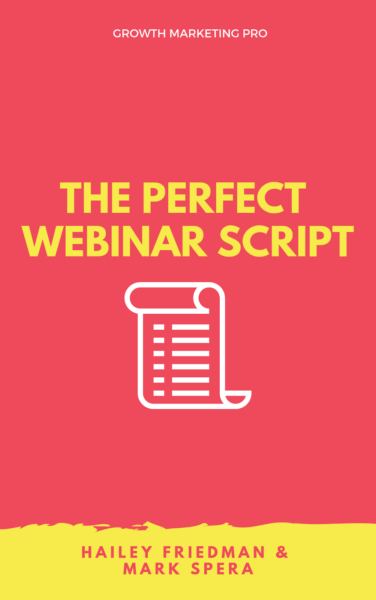Webinars are an incredible way to generate leads, enhance your email marketing, bolster content marketing efforts, and grow your business overall. Simply creating a webinar can position you as an authority in your niche and sell or market your product or service to an engaged audience.
When executed correctly with streamlined webinar software, webinars are a great way to convert leads into customers—paying customers.
The relatively low costs involved and the potential to reach hundreds, thousands, or more people makes webinar marketing one of the most attractive forms on online marketing from an ROI standpoint.
Yet, most people are doing it wrong and not seeing the kinds of results they should be.
Today we show you the right way to create a webinar that helps you better understand your audience, and more importantly, convert leads into customers.
Below are 9 key things you need to pay attention to and execute well if you want to convert warm, and even cold leads into customers via webinar marketing:
Write a script and clearly define your goals and objectives
Even the most experienced and skilled live hosts have a webinar script to follow. Obviously, you don’t want to sound like you’re reading from a script, and you don’t have to stick to it to the letter. But there are several benefits to having a script on hand, namely:
- It’ll help you remember key bits of information you want to get across
- You can include time markers to ensure you’re not running over
- You can make notes and jot down questions as they come in to answer at the end
When writing your script, define:
∙ What it is you’re selling
∙ The price
∙ Any incentive offers and deadlines
∙ The number of sales you want
I put together this webinar script template to help get you started.
Having a clear goal is motivating. Outline what you want to say for each slide in your deck and back up your visuals with as much factual data as possible. Citing sources for your data is fine, just be sure to provide all the information so your audience doesn’t need to do any of their own research.
If you’re going to host more webinars on the same topic in the future, your script and notes are a valuable and can help improve your presentation.
Wow the audience with your slide deck
We’ve all sat through a collection of dull and forgetful PowerPoint slides. A successful webinar inspires people to act.
Entertaining webinars perform better, that’s just a fact. According to this V12 survey, 73% of consumers are more likely to purchase a product if they can watch an explanation video beforehand. Of course, you broadcast your slides. If making entertaining and engaging slides is not your strong point, find someone who is good at it. In fact, don’t settle for good, you need exceptional slides.
Remember, your deck is the heart and soul of your webinar presentation. It’s what keeps your audience’s attention. From a design standpoint, they need to be colorful and easy to read. From an action standpoint, the information needs to be thorough if you’re going to convert leads into customers.
People who attend your webinar are usually warm leads, ready to convert. It’s your job to present your valuable information in a way that moves them beyond an interested party.
Be prepared, then prepare some more
You’ve probably heard the now overused Benjamin Franklin quote, “By failing to prepare you are preparing to fail.”
This statement rings no truer than when you’re creating and hosting a webinar. You’re going to be live in front of an audience. This means there’s very little room for errors, backtracking, realizing near the end you’ve missed something, and so on.
It’s perfectly normal to do a dry run-through of the entire webinar a few days before you’re scheduled to go live. You might even feel more comfortable going through it two, three, or more times.
This is important if you’re using new hardware or webinar software you’re unfamiliar with. Unexpected tech issues can mess with your mindset, so do a run-through to minimize any issues.
Before you think of presenting, you must have all your marketing materials ready too. Make a registration page and promote your webinar using social media, blog posts, or a Facebook ad.
Survey or poll your audience to see who’s ready to buy
Most webinar software gives you the ability to poll or survey your audience on the spot. Polls are a powerful way to find out what your attendees are looking to get out of the webinar, and how far in your sales funnel they are.
If the goal of your webinar is to convert leads into sales, you can use polls to:
- Segment your audience into cold, warm, and hot leads
- Find out what your audience is looking to get out of the webinar
- Identify the pain points of your attendees, helping you tailor your content to solving them
You can then use this information to segment your audience based on how close they are to buying. Then you can funnel them into the appropriate landing page.
Build trust and prove you’re an authority
Webinars are perfect for building trust and establishing yourself as an authority in your niche. They allow you to show people you know your stuff, and that you’re selling quality services.
If you want people to sign up for your services, there are a few ways you can do this. The most effective way is by showing social proof. Social proof comes in many forms, including case studies that show results from past clients, photos of your results or achievements, or positive comments and testimonials about you and your business,
The bigger and more well-known the person is that’s talking highly about you, the stronger the social proof. If you’re just starting out and don’t have much in the way of social proof, send out some emails and get some before holding a webinar. It’s that important.
Another way to do this is to include live chat within your webinar and answer questions on the fly. This will show off your knowledge and expertise.
Make it easy for your audience to buy
You risk losing a sale if buying from you isn’t easy and seamless. Even if you’re employing incentives. People want purchases to be convenient. Not seeing a call to action or having to fill out too many fields can cause them to think they’ll come back to it later.
We all know what happens when people say they will come back later. They often don’t.
Set up clean and clear landing pages for your leads. Make sure the buy button or any call to action is clear and visible when the page loads.
Use the Scarcity Principle
The Scarcity Principle is a psychological principle coined by Dr. Robert Cialdini. It’s a common sales tactic that encourages people who are considering a purchase to do so quickly before missing out.
It’s a tactic commonly used in internet marketing, whether the person using it is fully aware of the psychological effect or not. To apply the Scarcity Principle to your products or services, add a deadline for making a purchase.
You can either close the doors completely on what you’re selling after the deadline expires or set up some kind of special offer for anyone making a time-sensitive purchase.
Add value
Internet marketing is a competitive landscape. It’s gotten to the point where consumers expect to see added value to the basic purchase they are considering. It’s not totally unreasonable, especially when you consider they’ve given up 45-60 minutes of their time to attend your webinar.
Announce at the beginning of the webinar that you’ll be giving away some sort of bonus gift for anyone that stays to the end. Create a landing page where you give away one of your juiciest, most-coveted techniques.
The more value you can add, the higher chance there is that you’ll turn those warm leads into paying customers by the end of the webinar.
Utilize your email list and send out an email autoresponder series after the webinar
One of the benefits of holding a webinar is the boost to your email list. A percentage of attendees will leave the webinar on the fence about making a purchase. These are warm leads that can be converted with the right email after they’ve had time to think about it. It’s also the best place to offer an online course, if applicable, or enter them into drip campaign.
Use email marketing software to set up an email autoresponder series that will start emailing attendees as soon as the webinar has ended. Consider the following:
- Send out the bonus gift you promised them for watching to the end of the webinar and remind them of the deadline
- Send highlights of your slides showing key information about your products and services with a call to action to buy
- Send social proof and testimonials from customers that have benefited from your services with another call to action
- Ask the attendees that have not made a purchase what’s holding them back to see if you can help
- Send a final email with a discounted offer for people who have no other chance to buy

